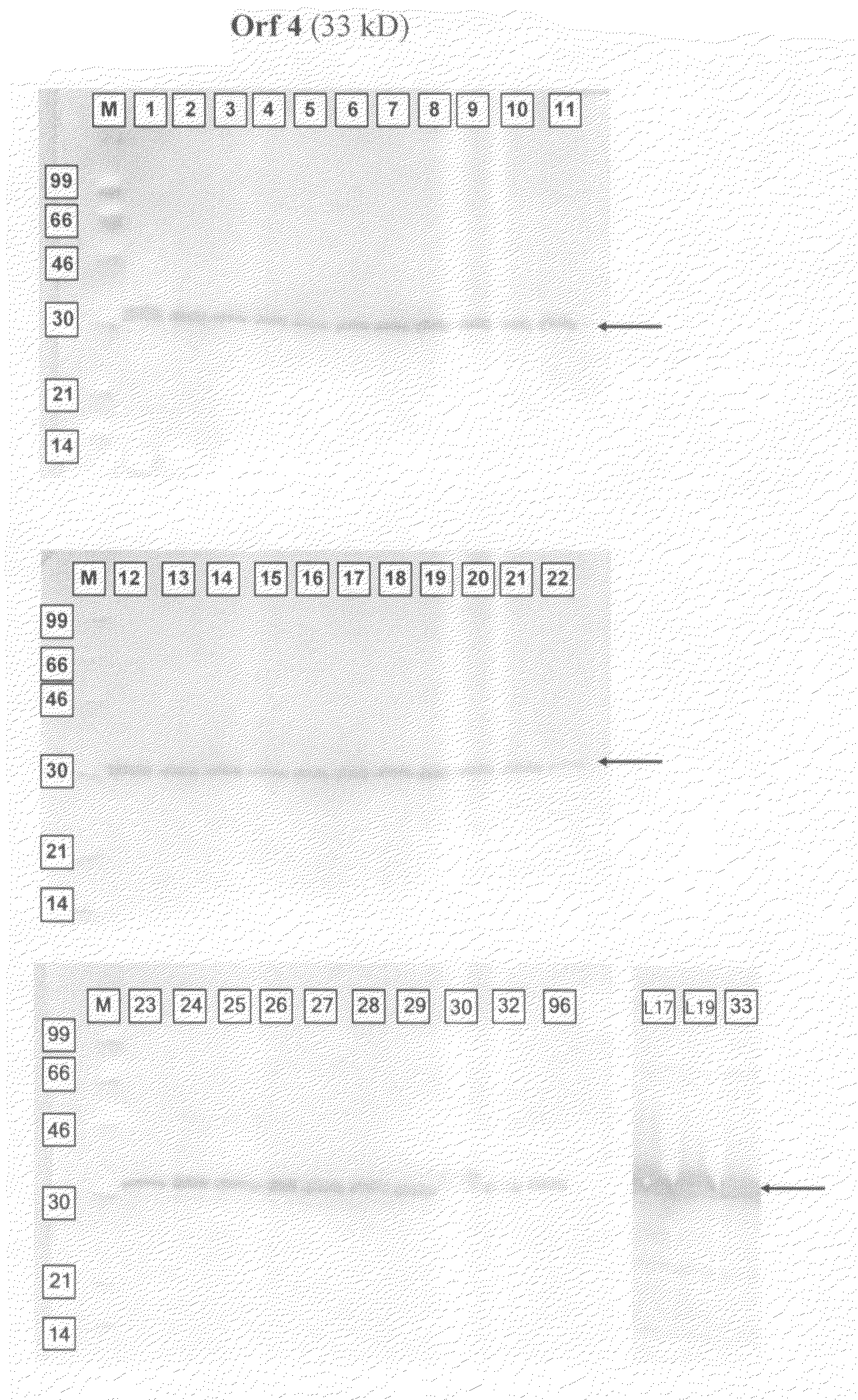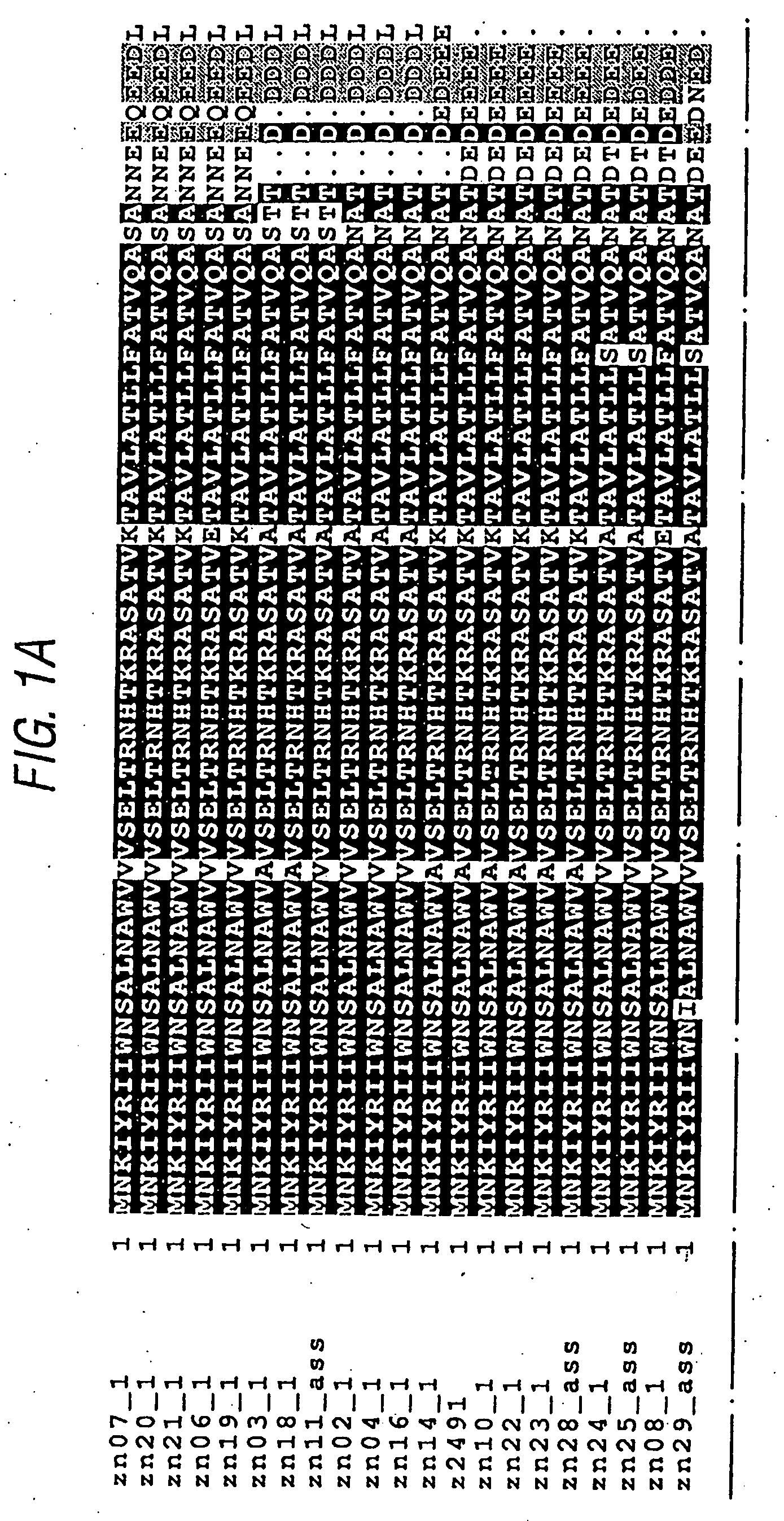Conserved neisserial antigens
a technology of neisseria bacteria and antigens, which is applied in the field of conservation of neisseria bacteria antigens, can solve the problems that the antigen variability of the approach cannot be overcome, and the antigen of the approach cannot be used for meningococcus b
- Summary
- Abstract
- Description
- Claims
- Application Information
AI Technical Summary
Benefits of technology
Problems solved by technology
Method used
Image
Examples
example 1
[0200]Example 1 of WO99 / 36544 discloses the cloning and expression of a Neisserial protein referred to as “ORF40”. Protein and DNA sequences from serogroup A and BN. meningitidis are disclosed, and the complete protein sequences show 83.7% identity over 601 aa overlap.
[0201]ORF40 was sequenced for a reference population of 21 strains of N. meningitidis:
IdentificationnumberStrainReferenceGroup Bzn02_1BZ198Seiler et al.(1996)zn03_1NG3 / 88Seiler et al.(1996)zn04_1297-0Seiler et al.(1996)zn06_1BZ147Seiler et al.(1996)zn07_1BZ169Seiler et al.(1996)zn08_1528Seiler et al.(1996)zn10_1BZ133Seiler et al.(1996)zh11_1assNGE31Seiler et al.(1996)zn14_1NGH38Seiler et al.(1996)zn16_1NGH15Seiler et al.(1996)zn18_1BZ232Seiler et al.(1996)zn19_1BZ83Seiler et al.(1996)zn20_144 / 76Seiler et al.(1996)zn21_1MC58Virji et al. (1992)Group Azn22_1205900Chiron SpAzn23_1F6124Chiron SpAz2491_1Z2491Maiden et al.(1998)Group Czn24_190 / 18311Chiron SpAzn25_1ass93 / 4286Chiron SpAOtherszn28_1ass860800 (group Y)Maiden et a...
example 2
[0206]Example 26 of WO99 / 24578 discloses the cloning and expression of a Neisserial protein referred to as “ORF4”. Protein and DNA sequences from serogroup A and B N. meningitidis are disclosed, along with sequences from N. gonorrhoeae. The identity between the sequences at an amino acid level are:
N. meningitidis AN. gonorrhoeaeN. meningitidis B99.7% over 287 aa97.6% over 288 aa
[0207]ORF4 was sequenced for a reference population of 32 strains of Neisseria:
IdentificationnumberStrainReferenceGroup Bzv01_4NG6 / 88Seiler et al. (1996)zv02_4BZ198Seiler et al. (1996)zv03_4assNG3 / 88Seiler et al. (1996)zv04_4297-0Seiler et al. (1996)zv05_41000Seiler et al. (1996)zv06_4BZ147Seiler et al. (1996)zv07_4BZ169Seiler et al. (1996)zv08_4528Seiler et al. (1996)zv09_4NGP165Seiler et al. (1996)zv10_4BZ133Seiler et al. (1996)zv11_4NGE31Seiler et al. (1996)zv12_4assNGF26Seiler et al. (1996)zv13_4NGE28Seiler et al. (1996)zv15_4′SWZ107Seiler et al. (1996)zv16_4NGH15Seiler et al. (1996)zv17_4NGH36Seiler et a...
example 3
[0212]Example 16 of WO99 / 57280 discloses the cloning and expression of a Neisserial protein referred to as “225”. Protein and DNA sequences from serogroup A and B N. meningitidis are disclosed, along with sequences from N. gonorrhoeae.
[0213]225 has now been sequenced for a reference population of 34 strains of Neisseria:
IdentificationnumberStrainSource referenceGroup Bzo01_225NG6 / 88Seiler et al., 1996zo02_225BZ198Seiler et al., 1996zo03_225NG3 / 88Seiler et al., 1996zo04_225297-0Seiler et al., 1996zo05_2251000Seiler et al., 1996zo06_225BZ147Seiler et al., 1996zo07_225BZ169Seiler et al., 1996zo08_225528Seiler et al., 1996zo09_225NGP165Seiler el al., 1996zo10_225BZ133Seiler et al., 1996zo11_225NGE31Seiler et al., 1996zo12_225NGF26Seiler et al., 1996zo13_225NGE28Seiler et al., 1996zo14_225NGH38Seiler et al., 1996zo15_225SWZ107Seiler et al., 1996zo16_225NGH15Seiler et al., 1996zo17_225NGH36Seiler et al., 1996zo18_225BZ232Seiler et al., 1996zo19_225BZ83Seiler et al., 1996zo20_22544 / 76Seil...
PUM
| Property | Measurement | Unit |
|---|---|---|
| size | aaaaa | aaaaa |
| Tm | aaaaa | aaaaa |
| exposure time | aaaaa | aaaaa |
Abstract
Description
Claims
Application Information
 Login to View More
Login to View More - R&D
- Intellectual Property
- Life Sciences
- Materials
- Tech Scout
- Unparalleled Data Quality
- Higher Quality Content
- 60% Fewer Hallucinations
Browse by: Latest US Patents, China's latest patents, Technical Efficacy Thesaurus, Application Domain, Technology Topic, Popular Technical Reports.
© 2025 PatSnap. All rights reserved.Legal|Privacy policy|Modern Slavery Act Transparency Statement|Sitemap|About US| Contact US: help@patsnap.com



